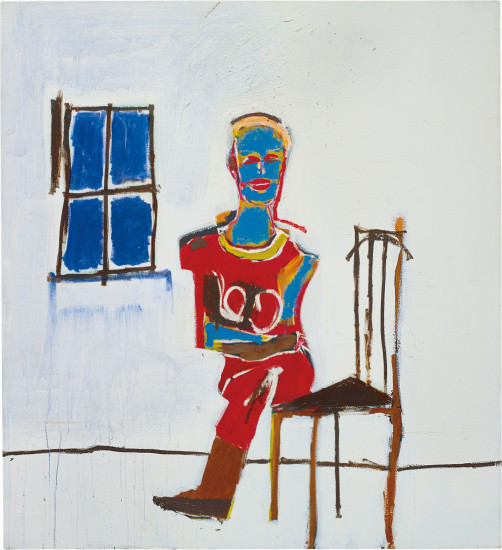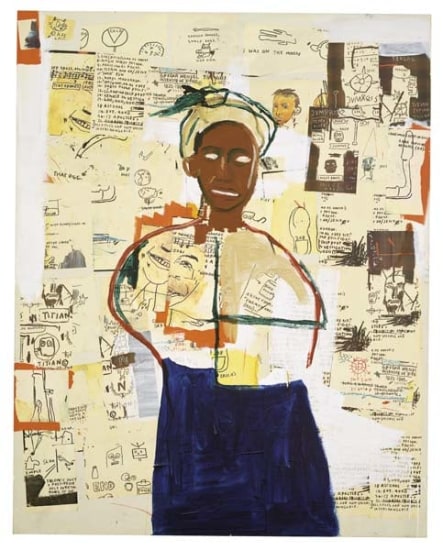Jean-Michel-Basquiat Self-Portrait Executed in 1982 Acrylic, oil stick and paper collage on canvas mounted on tied wood supports. 48 x 81 in. (121.9 x 205.7 cm). Signed, titled and dated ‘ “SELF PORTRAIT” 1982 Jean Michel Basquiat’ (on the reverse).
Provenance The Estate of Jean-Michel-Basquiat, New York; Robert Miller Gallery, New York; Private collection, Paris Exhibited New York, Museum of Modern Art, Allegories of Modernism Contemporary Drawing, February 15 – May 5, 1992; New York, Robert Miller Gallery, Jean-Michel-Basquiat. Works in Black and White, November 15, 1994 – January 7, 1995; Musee d’art moderne de la ville de Paris, Passions privées: Collections particulières d’art moderne et contemporain en France, December 16, 1995 – March 24, 1996, p. 152 (illustrated); New York, Brooklyn Museum; Los Angeles, The Museum of Contemporary Art; and Houston, The Museum of Fine Arts, Basquiat, March 11, 2005 – February 12, 2006, p. 151 (illustrated) Literature R. Marshall and J.L. Prat, Jean-Michel-Basquiat, Paris 1996, vol. 1, pp. 112 – 13 (illustrated); R. Marshall and J.L. Prat, Jean-Michel-Basquiat, Paris 2000, third edition, pp. 96, 106 and 107, no. 3 (illustrated) Catalogue Essay Jean-Michel-Basquiat, Self-Portrait Titled “SELF PORTRAIT” across the back of the canvas by the artist himself, in this early work, one of Basquiat’s most intimate and autobiographical pictures, the painter depicts himself as a man-child. The materials and the anatomy of the figure directly evoke the style of children’s drawings, and yet the picture manifests a depth of self-analysis that has few rivals in modern and contemporary art. Moreover, the painting’s frame, hand-made by the artist from scraps of a door frame, nailed and tied together with twine, gives it all the more personal a charge. It is a votive and reliquary, a tabernacle of memory and desire, hope and loss. And it makes the work as much a fetish or a sculpture as a painting. Working primarily with crayon-like oil stick, the artist consciously calls upon the simple forms of children’s art. He traces out a crude anatomy, with circles for knees and clubs for hands and feet. It is an outstanding example of Basquiat’s wide-ranging fascination with the power of primitive styles, including prehistoric rock-paintings, as well as tribal and voodoo traditions. Yet there is exceptional depth and complexity in his psychological self-portrayal, conveying all the ambiguity of human character. At first, the depiction seems to emphasize goodness. The figure stands square to the canvas in direct and open presentation. He hides nothing. He smiles. A halo floats above his head. But these initial impressions grow more ambiguous upon longer viewing. The boyish body and the frank disposition are countered by the exposed skeletal rib cage and the flaccid but adult-sized penis, highlighted in blue — death and sex emerge from the child’s frame. The innocent face, begging for love, threatens to change into a frightening mask, while the smile carries a latent charge of mischief, as though he might get into trouble the moment you turn away. And the halo is formed of barbwire: a modern crown of thorns. The world over, the child is a figure of absolute innocence and of uncontrolled impulse. Both manifestations are equally present in Basquiat’s extraordinary and powerful painting. As the halo makes obvious, Basquiat here draws on the tradition of self-portraiture that refers to scenes from the life of Christ. Deeply rooted in European art, this tradition begins with Dürer. The simple pose of the figure harks back to a classic form in Christian imagery. “Ecce Homo” — Behold Man — said Pontius Pilate when he displayed Christ to the crowd after his scourging and before the crucifixion. This moment inspired some of the most powerful images in Western art of a lonely and tormented figure standing exposed. One famous example is Rembrandt’s print of the scene; it also stimulated deeply moving paintings by Caravaggio, Titian, Mantegna and many others. In a step with tremendous implications for the history of later art, at the beginning of the eighteenth century, Watteau transformed the scene of Ecce Homo into a type for the Artist, innocently offering himself and hi
Jean-Michel-Basquiat Self-Portrait Executed in 1982 Acrylic, oil stick and paper collage on canvas mounted on tied wood supports. 48 x 81 in. (121.9 x 205.7 cm). Signed, titled and dated ‘ “SELF PORTRAIT” 1982 Jean Michel Basquiat’ (on the reverse).
Provenance The Estate of Jean-Michel-Basquiat, New York; Robert Miller Gallery, New York; Private collection, Paris Exhibited New York, Museum of Modern Art, Allegories of Modernism Contemporary Drawing, February 15 – May 5, 1992; New York, Robert Miller Gallery, Jean-Michel-Basquiat. Works in Black and White, November 15, 1994 – January 7, 1995; Musee d’art moderne de la ville de Paris, Passions privées: Collections particulières d’art moderne et contemporain en France, December 16, 1995 – March 24, 1996, p. 152 (illustrated); New York, Brooklyn Museum; Los Angeles, The Museum of Contemporary Art; and Houston, The Museum of Fine Arts, Basquiat, March 11, 2005 – February 12, 2006, p. 151 (illustrated) Literature R. Marshall and J.L. Prat, Jean-Michel-Basquiat, Paris 1996, vol. 1, pp. 112 – 13 (illustrated); R. Marshall and J.L. Prat, Jean-Michel-Basquiat, Paris 2000, third edition, pp. 96, 106 and 107, no. 3 (illustrated) Catalogue Essay Jean-Michel-Basquiat, Self-Portrait Titled “SELF PORTRAIT” across the back of the canvas by the artist himself, in this early work, one of Basquiat’s most intimate and autobiographical pictures, the painter depicts himself as a man-child. The materials and the anatomy of the figure directly evoke the style of children’s drawings, and yet the picture manifests a depth of self-analysis that has few rivals in modern and contemporary art. Moreover, the painting’s frame, hand-made by the artist from scraps of a door frame, nailed and tied together with twine, gives it all the more personal a charge. It is a votive and reliquary, a tabernacle of memory and desire, hope and loss. And it makes the work as much a fetish or a sculpture as a painting. Working primarily with crayon-like oil stick, the artist consciously calls upon the simple forms of children’s art. He traces out a crude anatomy, with circles for knees and clubs for hands and feet. It is an outstanding example of Basquiat’s wide-ranging fascination with the power of primitive styles, including prehistoric rock-paintings, as well as tribal and voodoo traditions. Yet there is exceptional depth and complexity in his psychological self-portrayal, conveying all the ambiguity of human character. At first, the depiction seems to emphasize goodness. The figure stands square to the canvas in direct and open presentation. He hides nothing. He smiles. A halo floats above his head. But these initial impressions grow more ambiguous upon longer viewing. The boyish body and the frank disposition are countered by the exposed skeletal rib cage and the flaccid but adult-sized penis, highlighted in blue — death and sex emerge from the child’s frame. The innocent face, begging for love, threatens to change into a frightening mask, while the smile carries a latent charge of mischief, as though he might get into trouble the moment you turn away. And the halo is formed of barbwire: a modern crown of thorns. The world over, the child is a figure of absolute innocence and of uncontrolled impulse. Both manifestations are equally present in Basquiat’s extraordinary and powerful painting. As the halo makes obvious, Basquiat here draws on the tradition of self-portraiture that refers to scenes from the life of Christ. Deeply rooted in European art, this tradition begins with Dürer. The simple pose of the figure harks back to a classic form in Christian imagery. “Ecce Homo” — Behold Man — said Pontius Pilate when he displayed Christ to the crowd after his scourging and before the crucifixion. This moment inspired some of the most powerful images in Western art of a lonely and tormented figure standing exposed. One famous example is Rembrandt’s print of the scene; it also stimulated deeply moving paintings by Caravaggio, Titian, Mantegna and many others. In a step with tremendous implications for the history of later art, at the beginning of the eighteenth century, Watteau transformed the scene of Ecce Homo into a type for the Artist, innocently offering himself and hi

.jpg)









Testen Sie LotSearch und seine Premium-Features 7 Tage - ohne Kosten!
Lassen Sie sich automatisch über neue Objekte in kommenden Auktionen benachrichtigen.
Suchauftrag anlegen